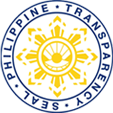
Sec. 93. Transparency Seal. To enhance transparency and enforce accountability, all national government agencies shall maintain a transparency seal on their official websites. The transparency seal shall contain the following information: (i) the agency’s mandates and functions, names of its officials with their position and designation, and contact information; (ii) annual reports, as required under National Budget Circular Nos. 507 and 507-A dated January 31, 2007 and June 12, 2007, respectively, for the last three (3) years; (iii) their respective approved budgets and corresponding targets immediately upon approval of this Act; (iv) major programs and projects categorized in accordance with the five key results areas under E.O. No. 43, s. 2011; (v) the program/projects beneficiaries as identified in the applicable special provisions; (vi) status of implementation and program/project evaluation and/or assessment reports; and (vii) annual procurement plan, contracts awarded and the name of contractors / suppliers / consultants.
The respective heads of the agencies shall be responsible for ensuring compliance with this section.
A Transparency Seal, prominently displayed on the main page of the website of a particular government agency, is a certificate that it has complied with the requirements of Section 93. This Seal links to a page within the agency’s website which contains an index of downloadable items of each of the above-mentioned documents.
Symbolism
A pearl buried inside a tightly-shut shell is practically worthless. Government information is a pearl, meant to be shared with the public in order to maximize its inherent value.
The Transparency Seal, depicted by a pearl shining out of an open shell, is a symbol of a policy shift towards openness in access to government information. On the one hand, it hopes to inspire Filipinos in the civil service to be more open to citizen engagement; on the other, to invite the Filipino citizenry to exercise their right to participate in governance.
This initiative is envisioned as a step in the right direction towards solidifying the position of the Philippines as the Pearl of the Orient – a shining example for democratic virtue in the region.